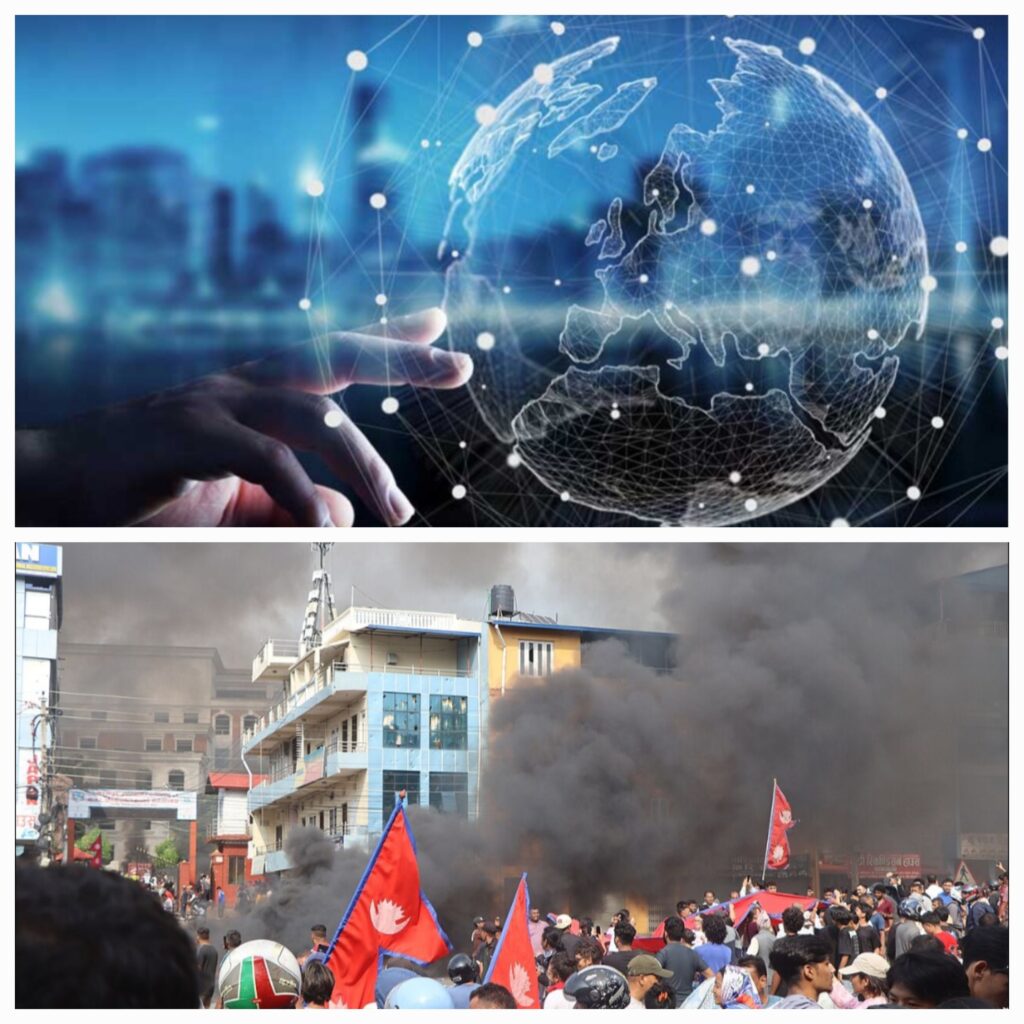By: Brig AJA Pereira, SM (Retd)

“The great danger of the modern world is that we are drowning in information but starved for wisdom,” warned historian EO Wilson. In the last two decades, digital technologies have shrunk the world into a smartphone which is just a click away from global currents of news, outrage, and protest. This easy and cheap access has empowered individuals, democratized information, and amplified voices that were once silent. But it has also made societies more vulnerable, exposing fault lines within nations and creating fertile ground for unrest. The paradox of our age is clear: the world has become smaller, but far more divided.
The story of digital revolutions began in Tunisia when the self-immolation of Mohamed Bouazizi in 2010 set off a firestorm, carried not just by word of mouth but by Facebook posts, X hashtags, and YouTube videos. The Arab Spring spread across North Africa and West Asia, toppling regimes and unsettling entrenched powers. Similar waves of unrest touched Ukraine, leading to the Orange Revolution, and rippled further into South and Southeast Asia. In our immediate neighbourhood, Pakistan saw protests against corruption and military dominance, Sri Lankan economic crisis morphed into mass unrest, Bangladesh’s student protests snowballed and now Nepal is simmering with same volatile mix of popular frustration and internet-fuelled dissent. What unites these disparate movements is not geography, ideology, or leadership but technology. Social media platforms, almost all owned by the Western world provide the launch pad for outrage, stage for mobilization, and the echo chambers for anger.
These platforms that connect families also spread calls for disobedience, glorify violence, and erode faith in institutions. It is no longer a secret that the content individuals consume is curated not by choice but by algorithms. A subtle tweak in ranking systems or recommendations can amplify anger, spread disinformation, or radicalise entire groups. This begins by igniting internal strife due to economic inequality, corruption, or governance failures, followed by digital amplification and mass mobilization which leads to breakdown of law and order followed by regime change or instability. This “playbook” is not accidental. It thrives on societal divides and digital manipulation, leaving nations fractured long after the protests fade. The pattern has repeated with disturbing similarity across countries.
For China, these “digital revolutions” are existential threats of external manipulation disguised as popular uprisings. Unlike other nations, China has invested in a fully indigenous digital ecosystem i.e. WeChat (WhatsApp, Facebook, PayPal combined), Douyin (TikTok), Weibo (X), Xiaohongshu (Pinterest and Instagram), Bilibili (YouTube), Zhihu (Quora), Youku (YouTube and Netflix) etc. These platforms operate under strict surveillance and censorship by the Chinese Communist Party, ensuring that narratives challenging the state are swiftly neutralized. The “Great Firewall” keeps Western platforms largely out, insulating the population from external influence. In this way, China has created a digital sovereignty model that prioritizes regime stability above individual freedom.
Pakistan has a nationwide firewall to block and filter internet content with advanced technology from China’s Geedge Networks, with components from the U.S and France. Countries like Russia, North Korea, Iran, Vietnam, and Myanmar have also implemented similar systems of censorship and control influenced by Chinese technology and policies.
India presents the opposite picture. We are deeply reliant on Western technologies be it Google’s Android, Apple’s iOS, Microsoft’s Windows, Facebook, Instagram, X, and YouTube etc. Nearly every aspect of our digital life is dependent on foreign operating systems, hardware, and platforms. Layered on top of this is our own social reality which is fractured along caste, religion, language, and class. These divides make us particularly vulnerable to the same “digital revolution” playbook that has destabilized our neighbours. A single manipulated narrative, amplified through millions of smartphones, could easily tip local unrest into nationwide crisis.
In order to be a global power, we must secure our digital sovereignty. We need to accelerate the creation of homegrown social media platforms, search engines, and digital tools that can compete with foreign platforms while ensuring accountability. Investment in secure, indigenous operating systems, chips, and cloud infrastructure is critical to reduce dependency on external powers. A robust legal and regulatory framework must define how foreign platforms should operate in India. Citizens must be educated to identify disinformation and resist digital manipulation. A digitally literate society is less prone to being swayed by orchestrated narratives. Ultimately, the best defence is unity. Addressing internal inequalities and promoting social cohesion will blunt the effectiveness of digital triggers.
Digital technologies have shrunk the world but have also turned local sparks into global wildfires. The revolutions from Tunisia to Tehran and Sri Lanka to Nepal reveal a consistent pattern of unrest amplified by Western-controlled social media, leaving societies weakened and divided. To prevent becoming the next domino in this chain of digital revolutions, we must build indigenous capacity, reduce foreign dependency, and strengthen our social cohesion to survive and prevail in the digital age.

About the Author
Brigadier Anil John Alfred Pereira, SM (Retd) is Indian Army Veteran from Goa, who served the nation with distinction for 32 years.


internet chick Awesome! Its genuinely remarkable post, I have got much clear idea regarding from this post . internet chick